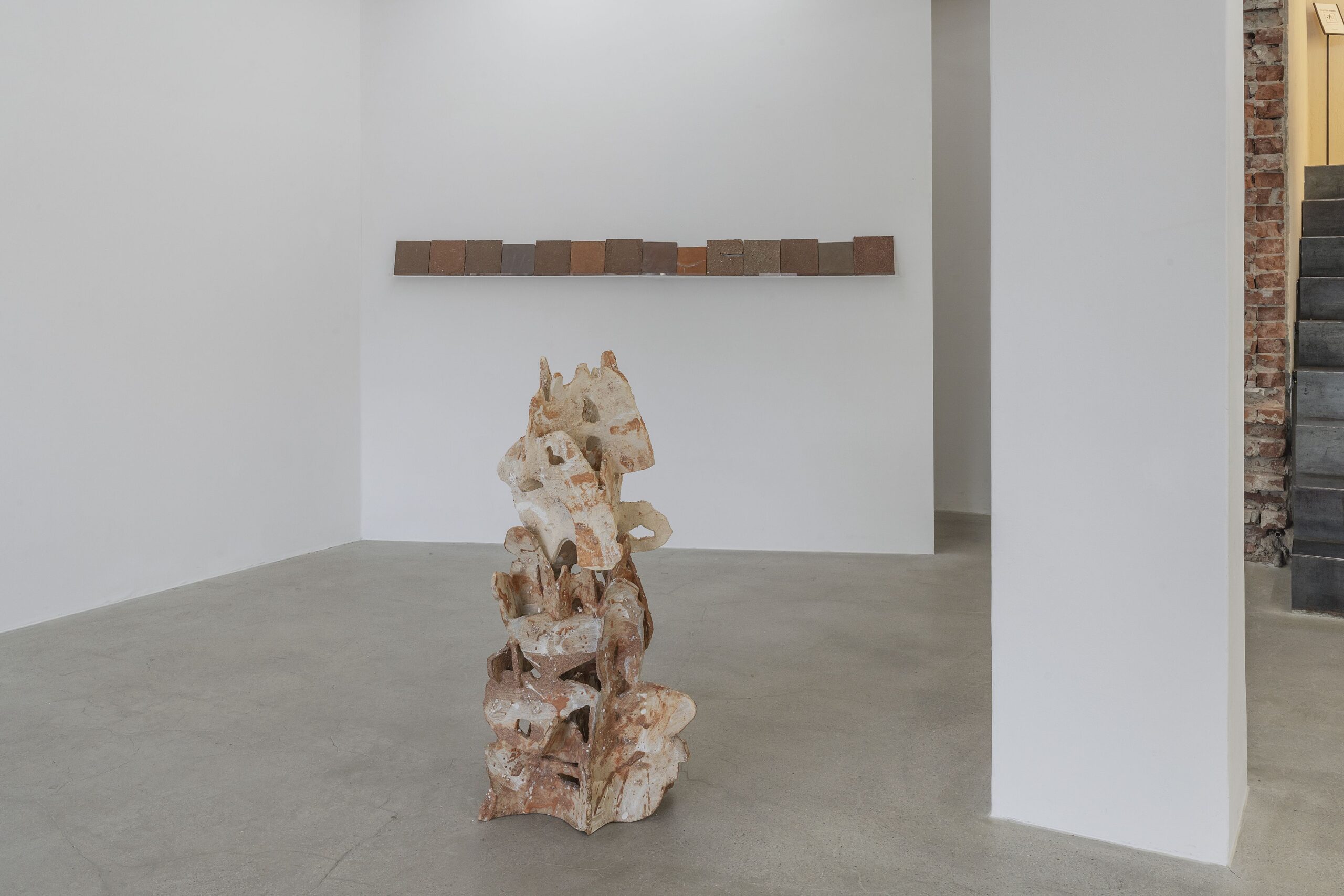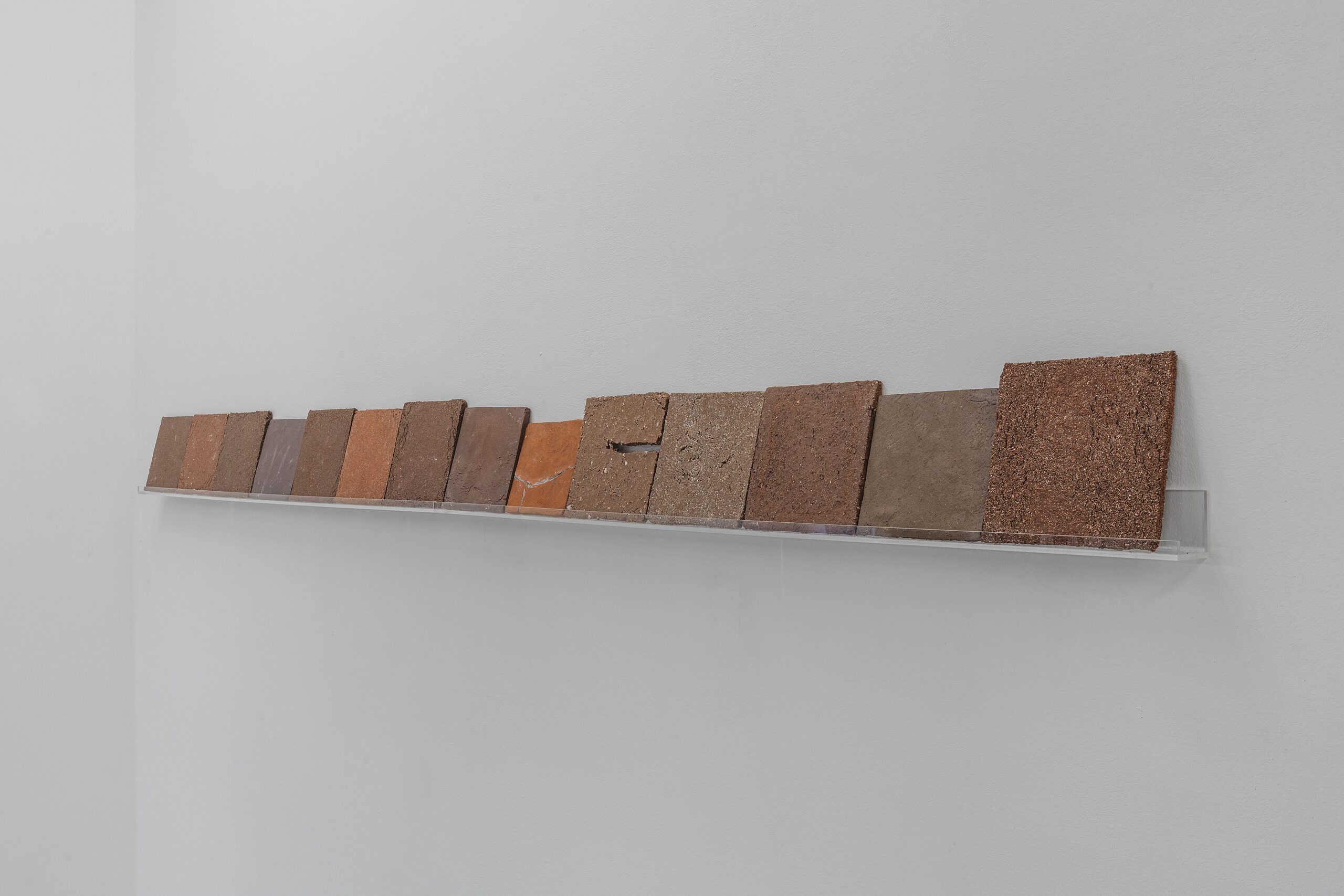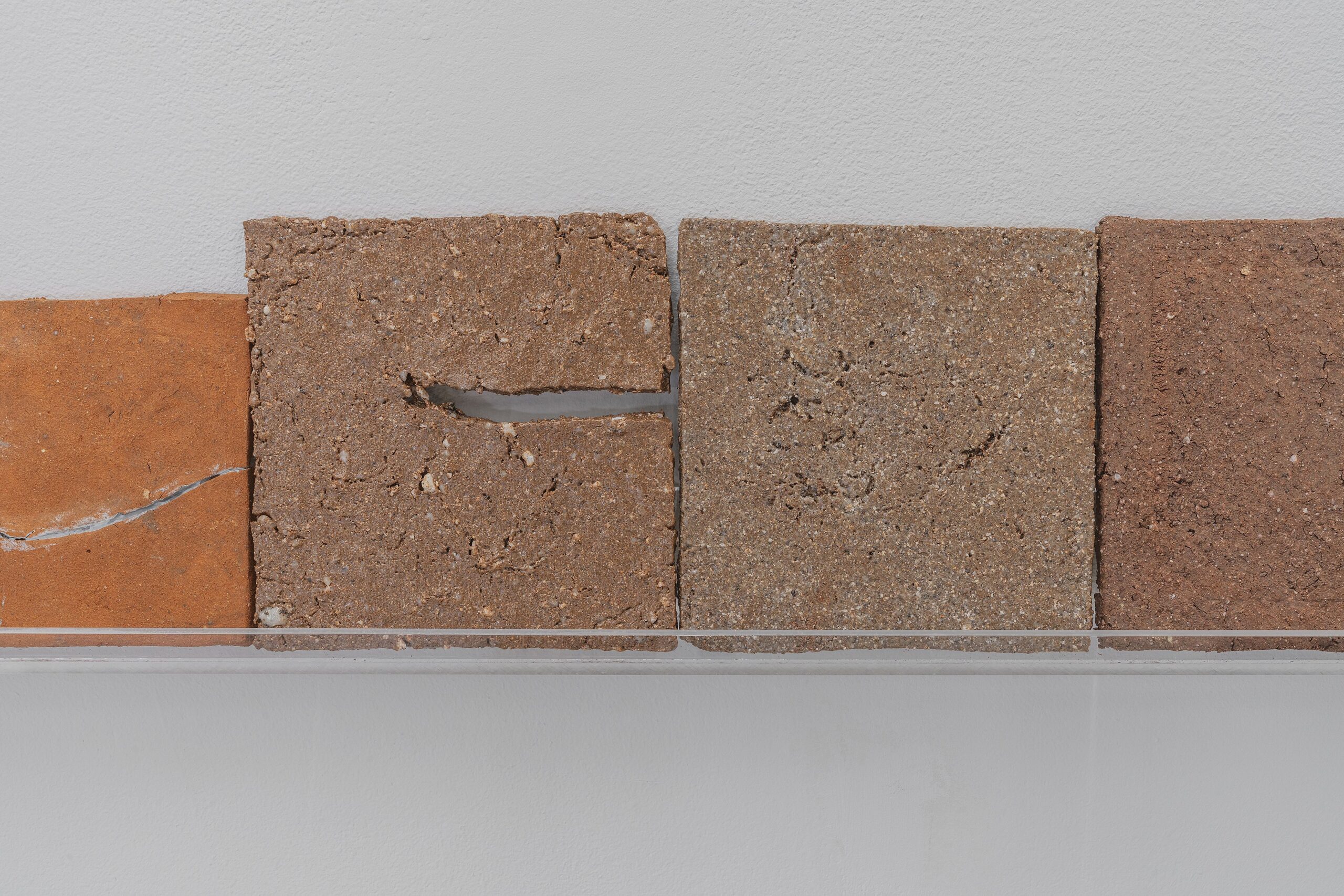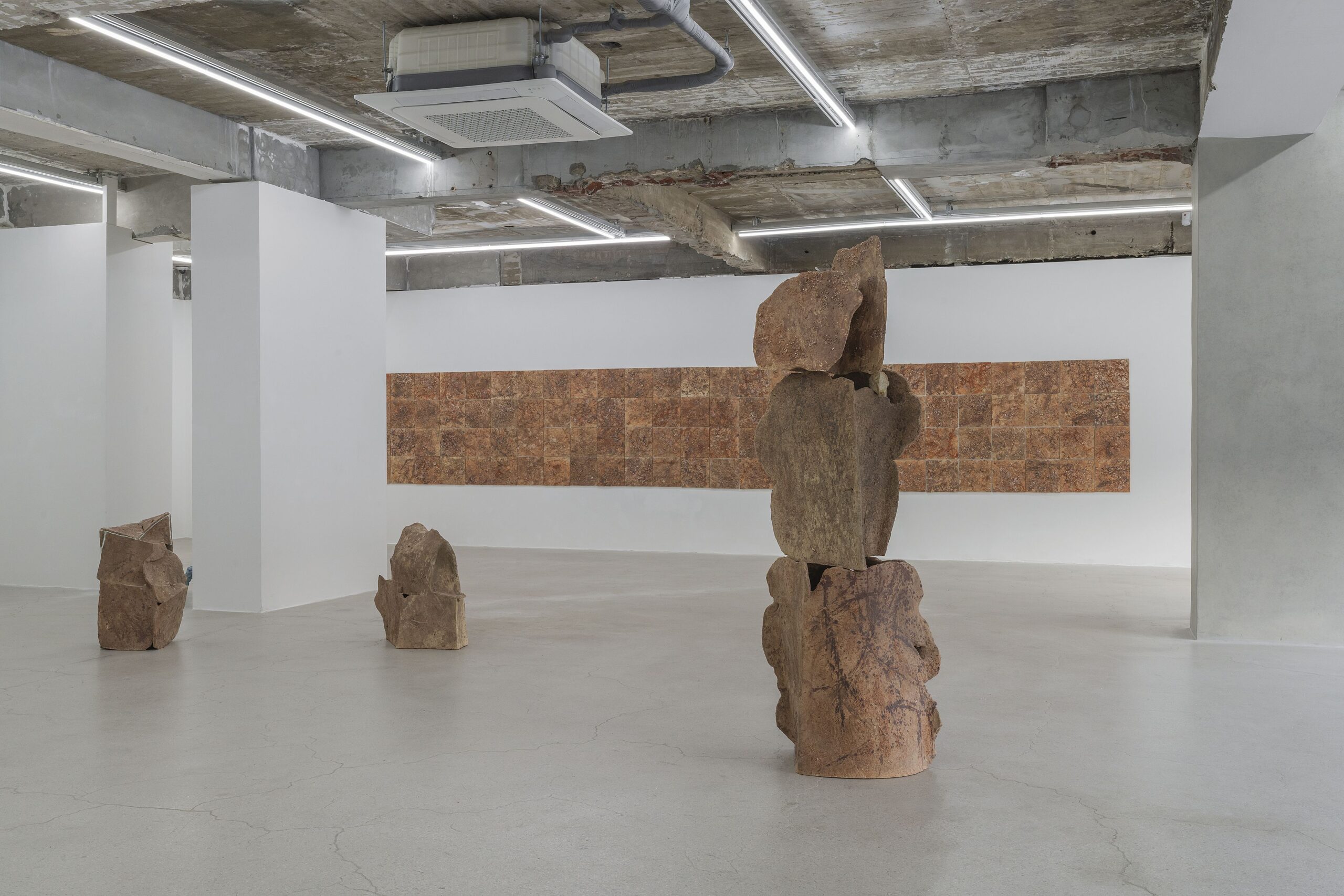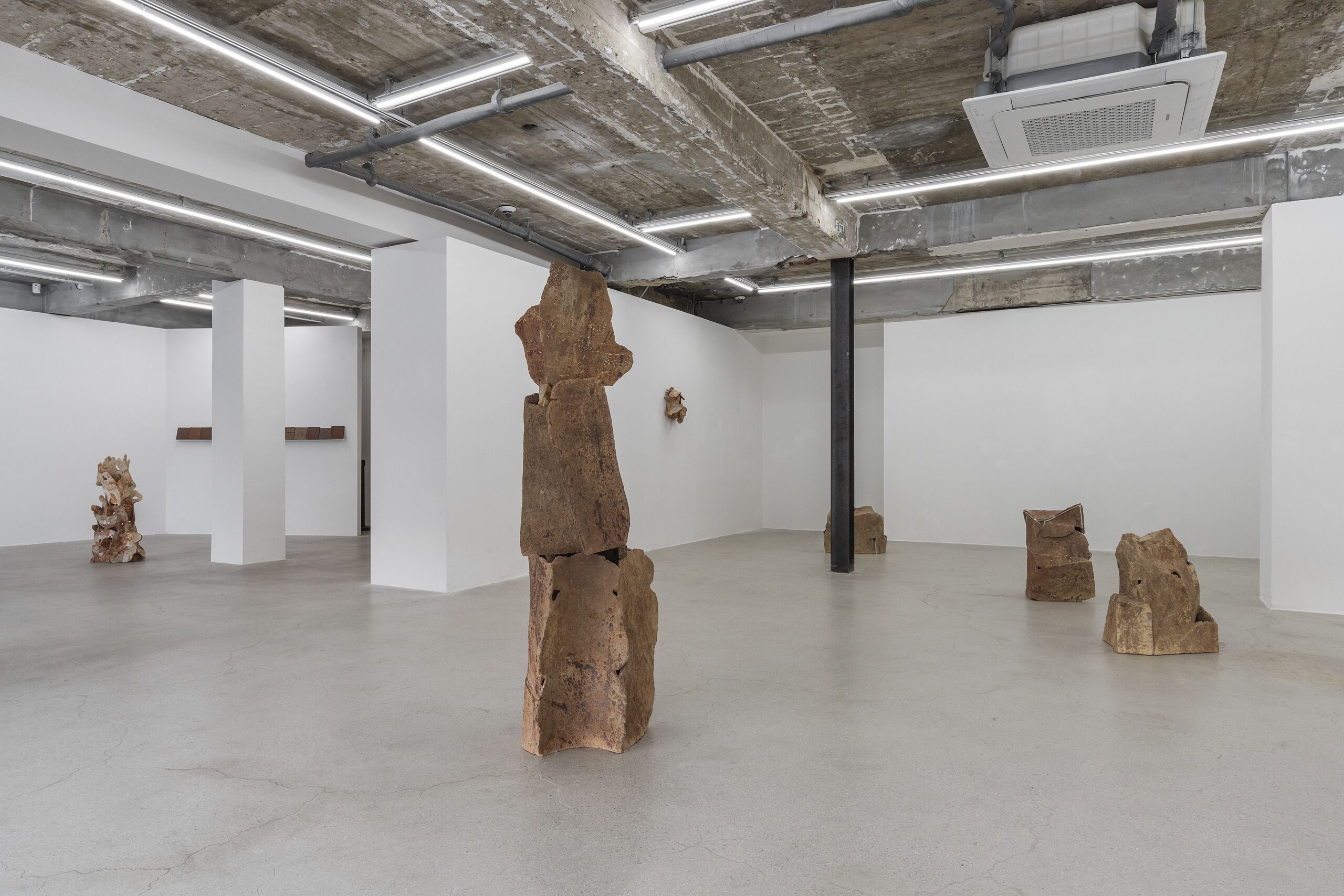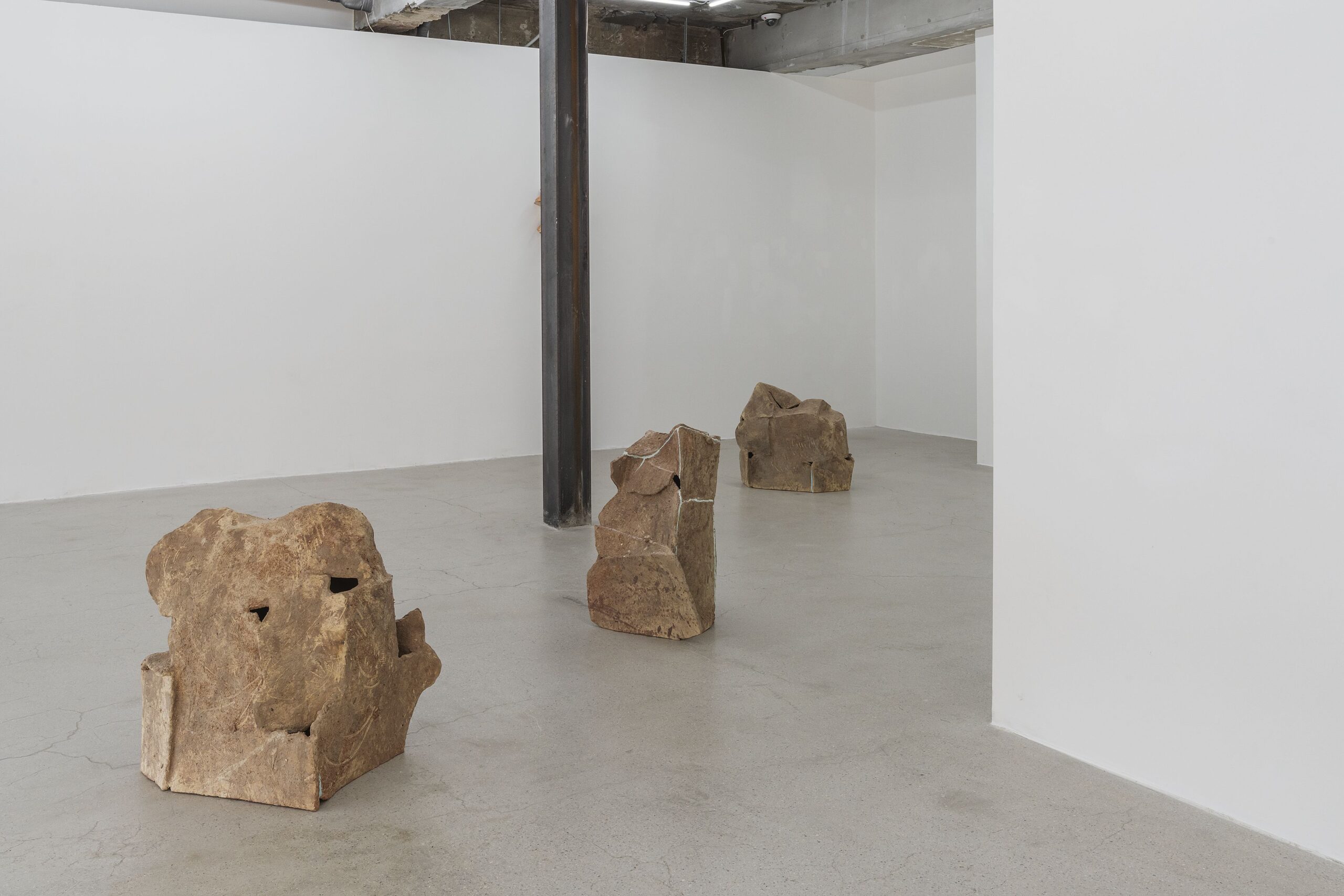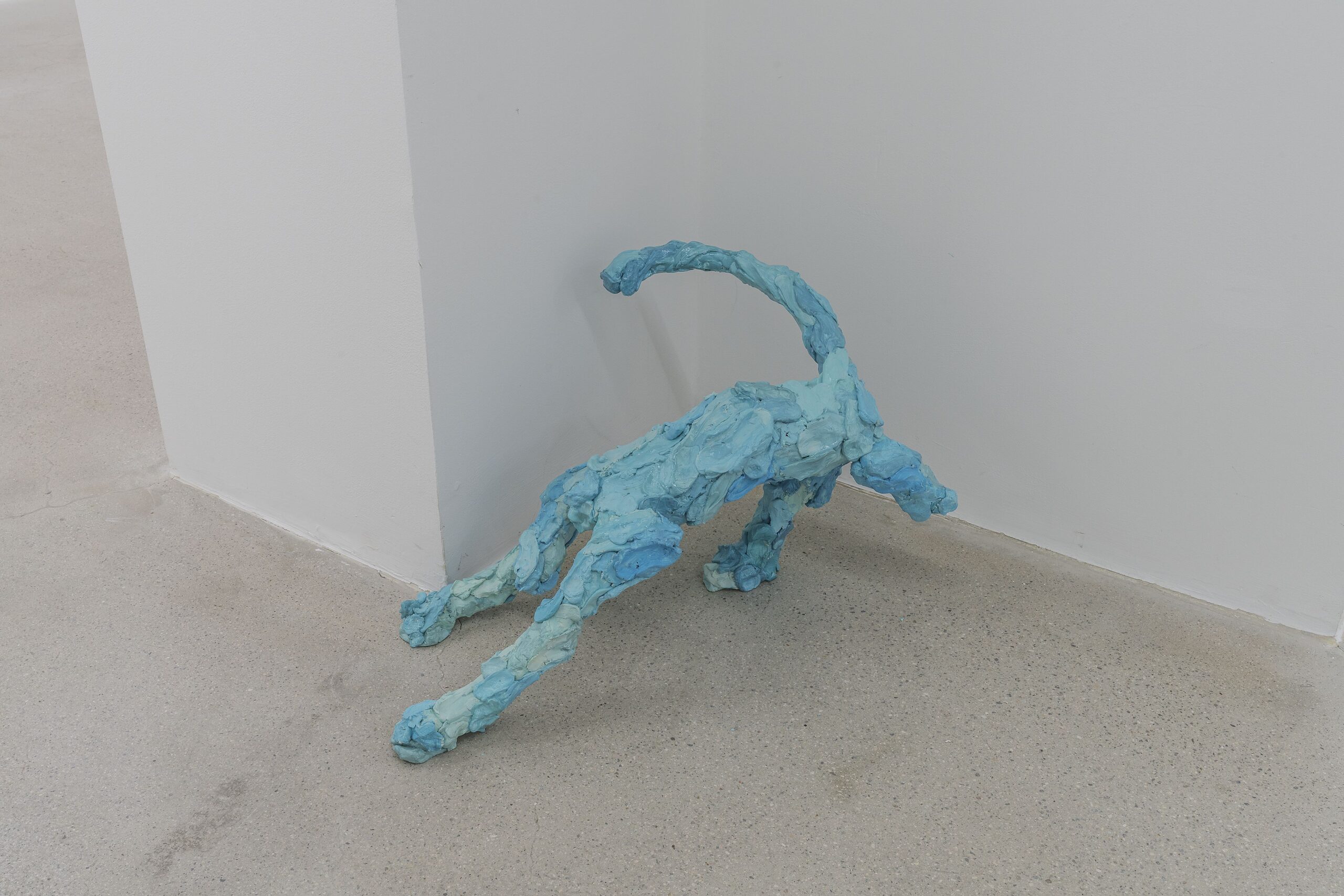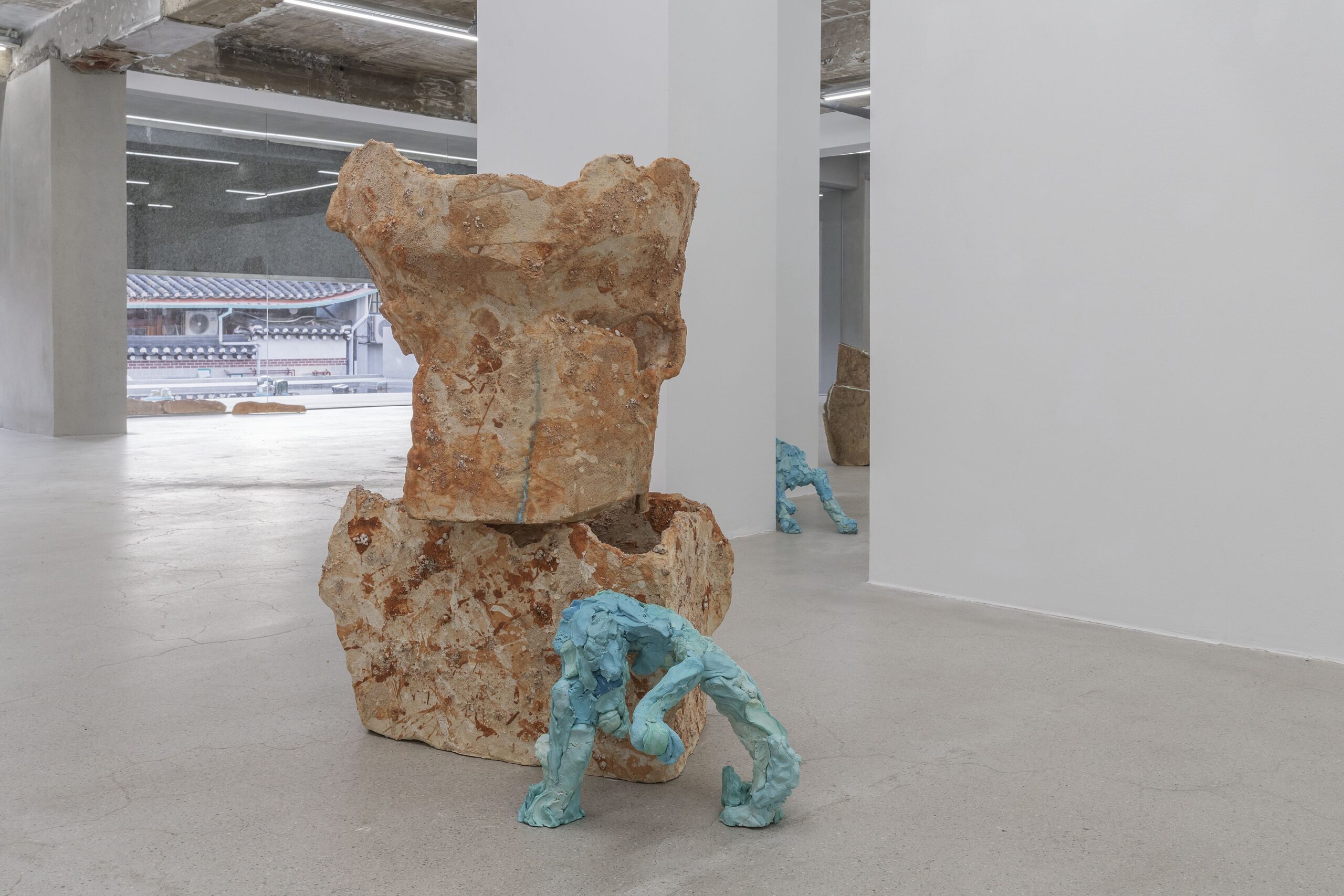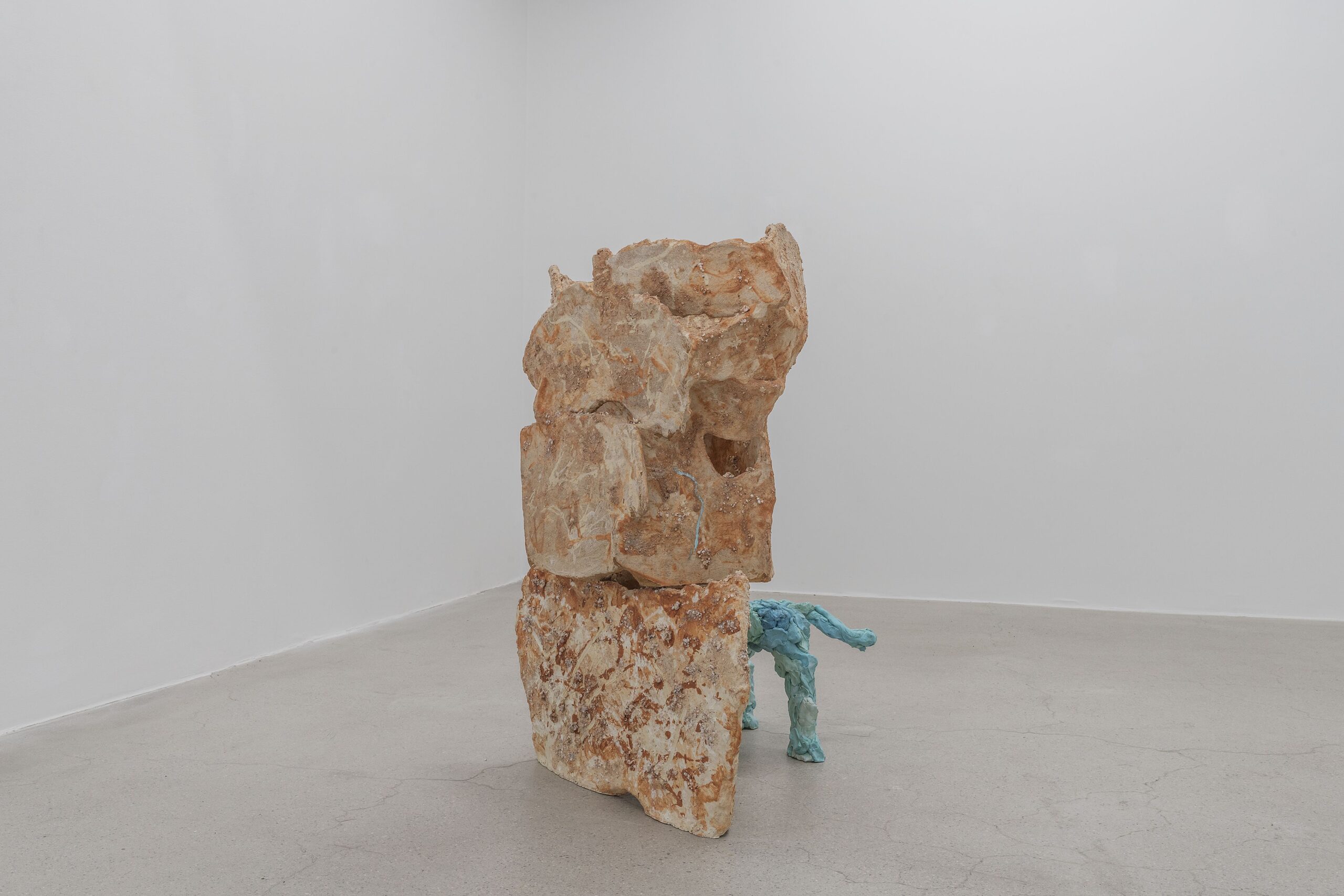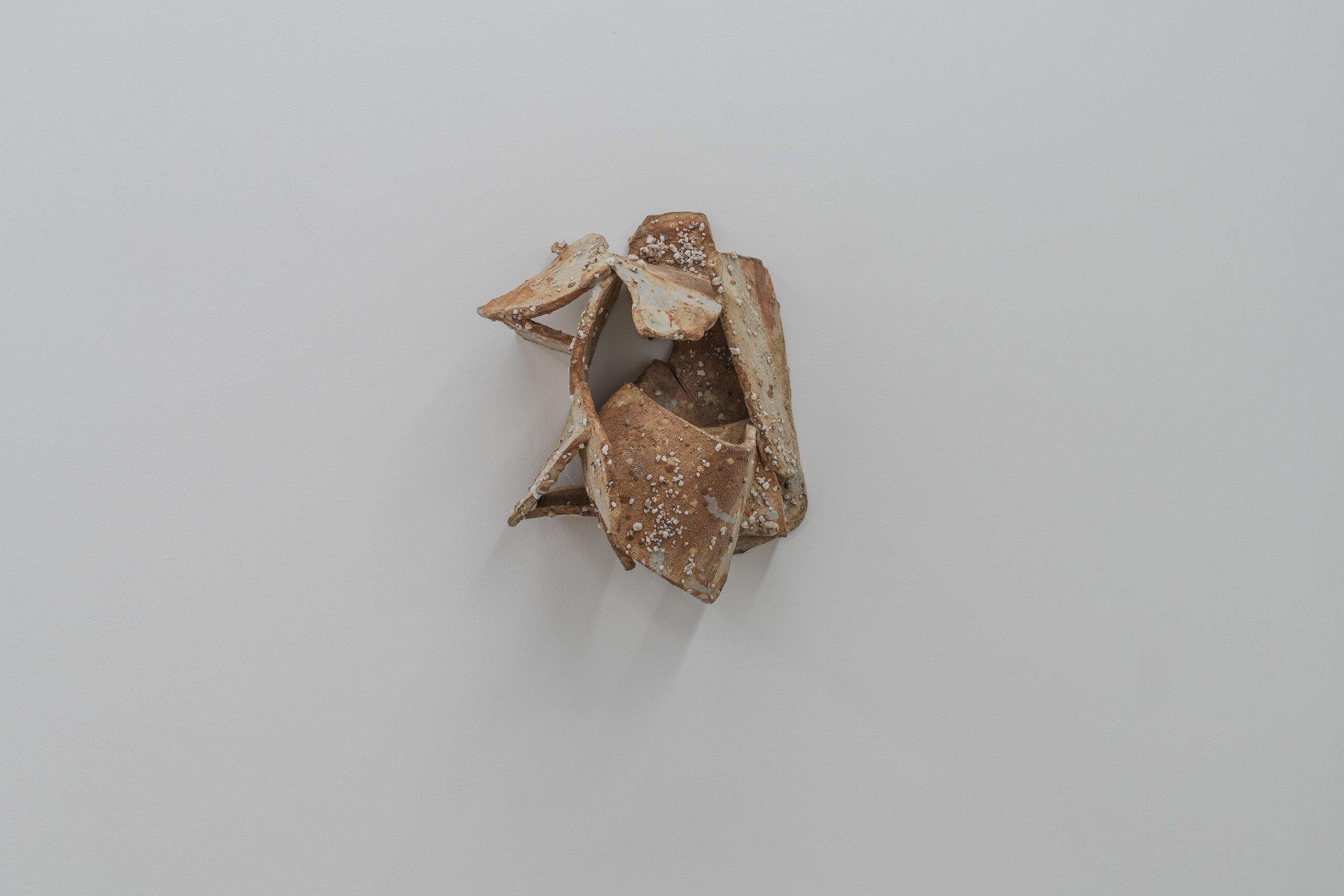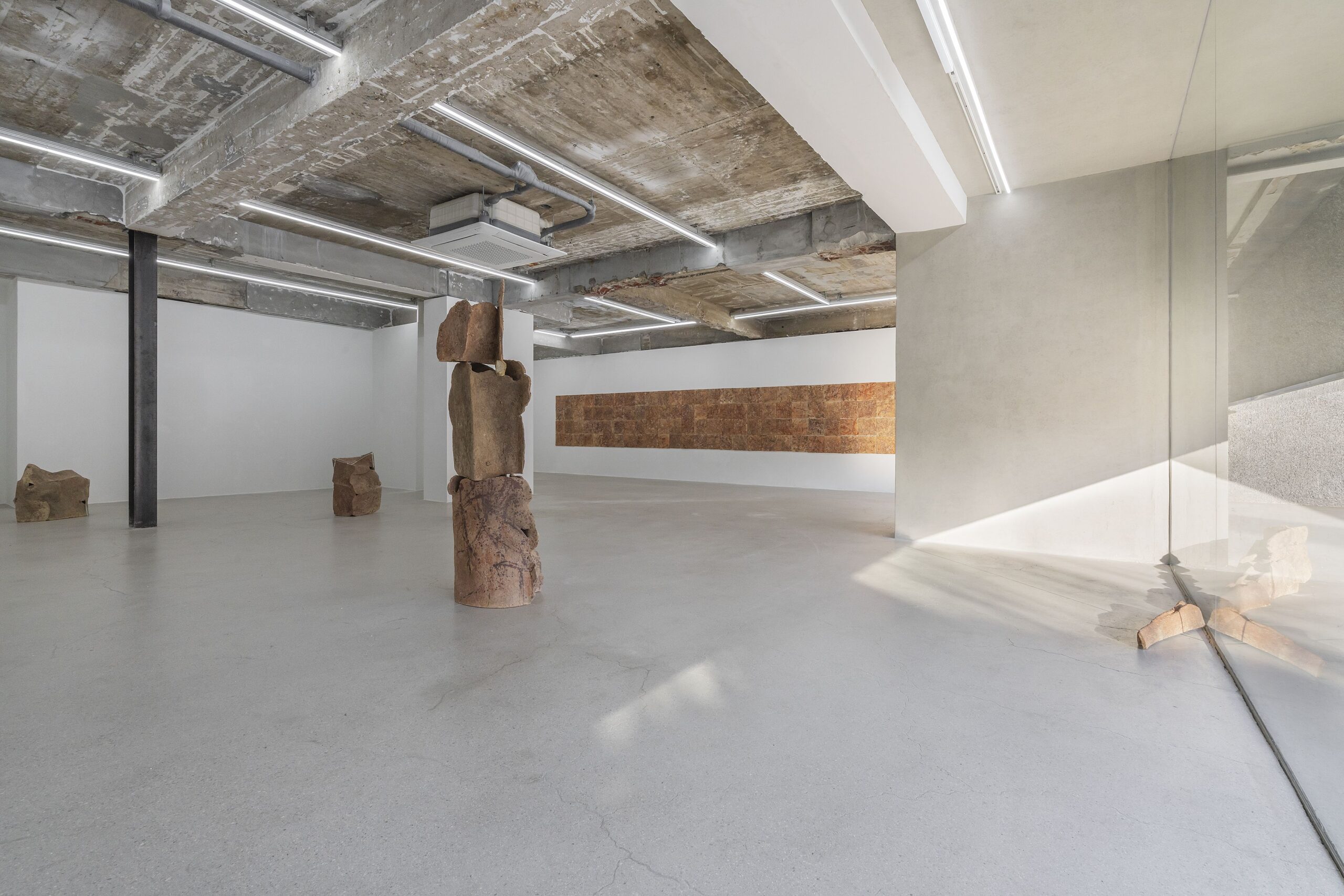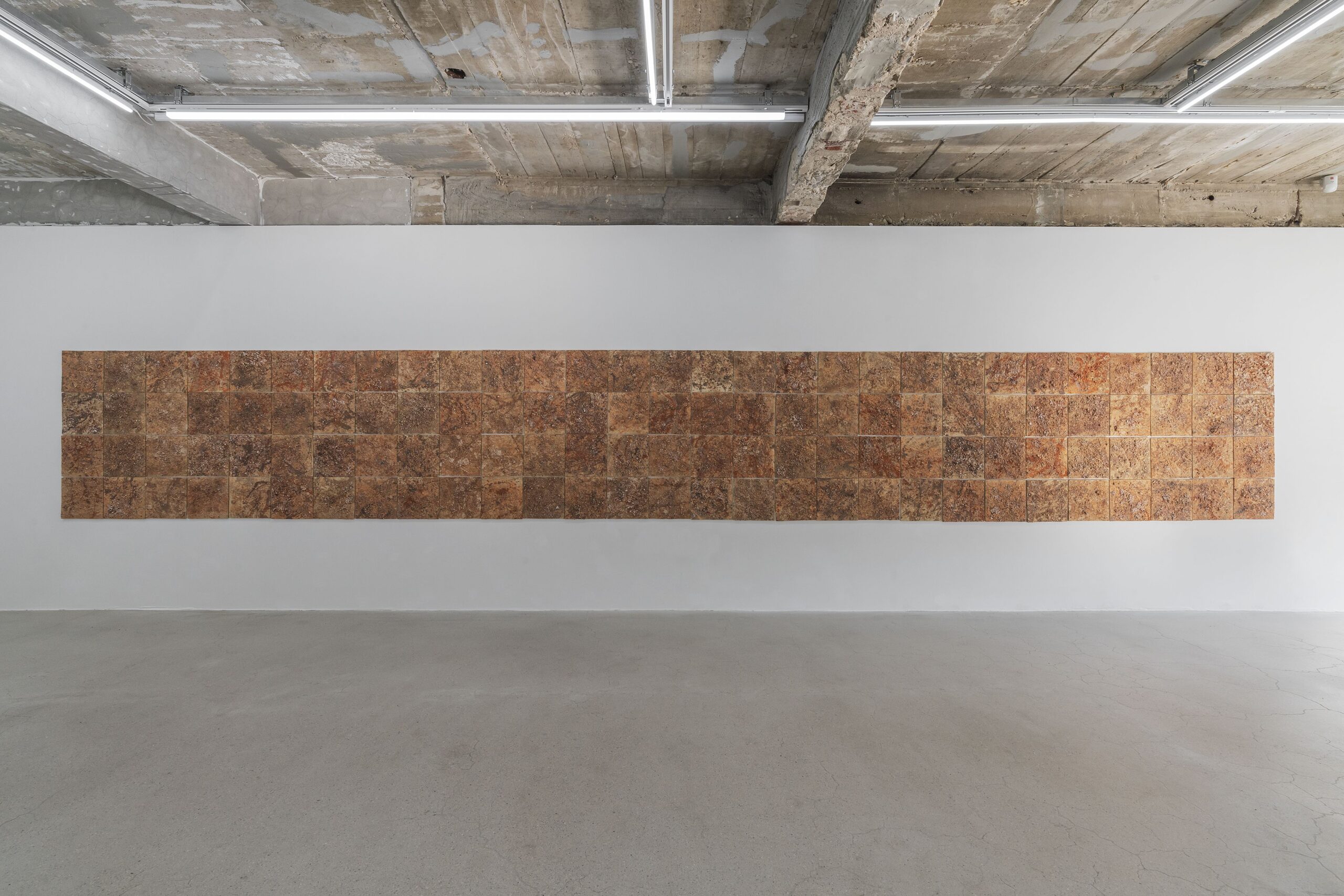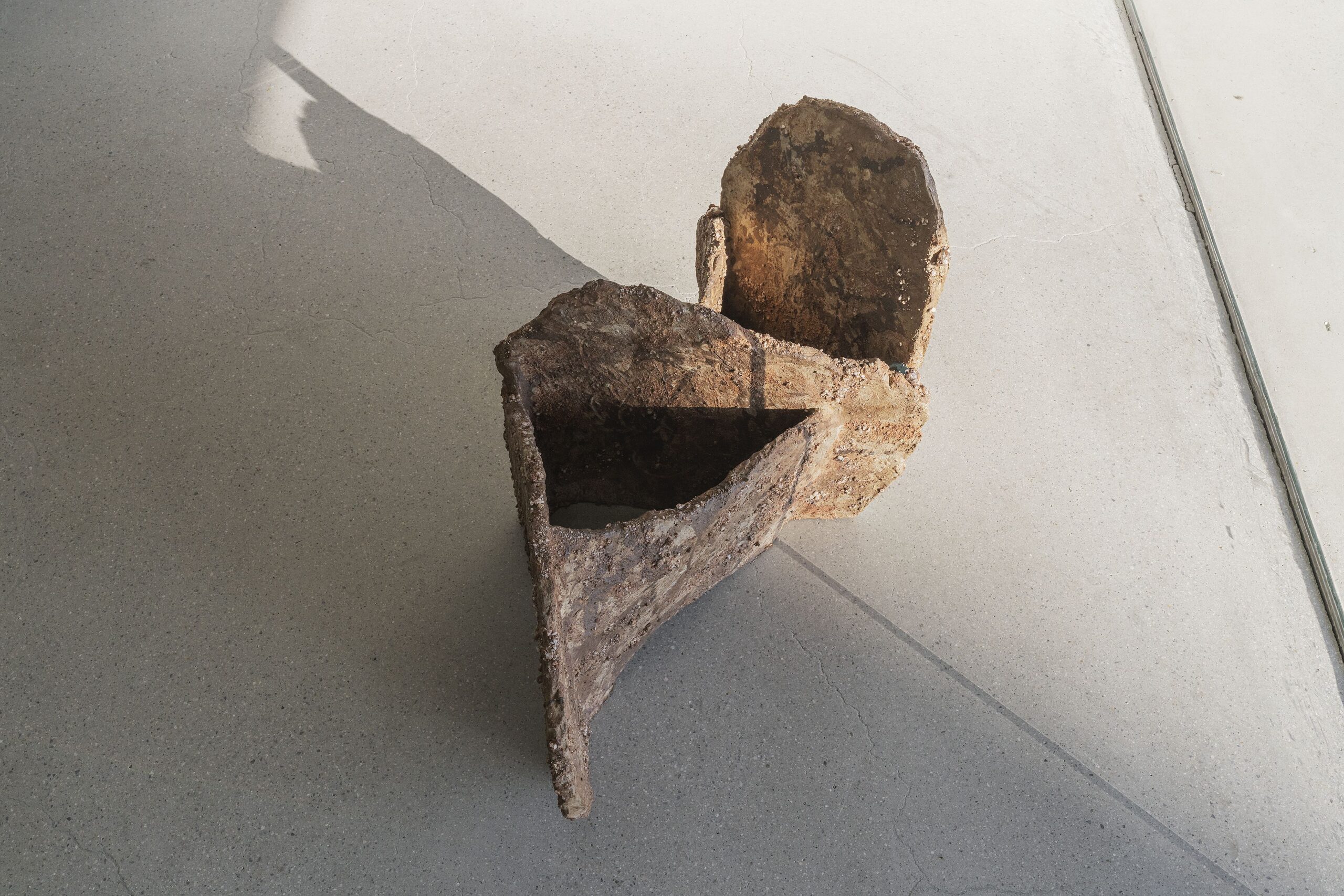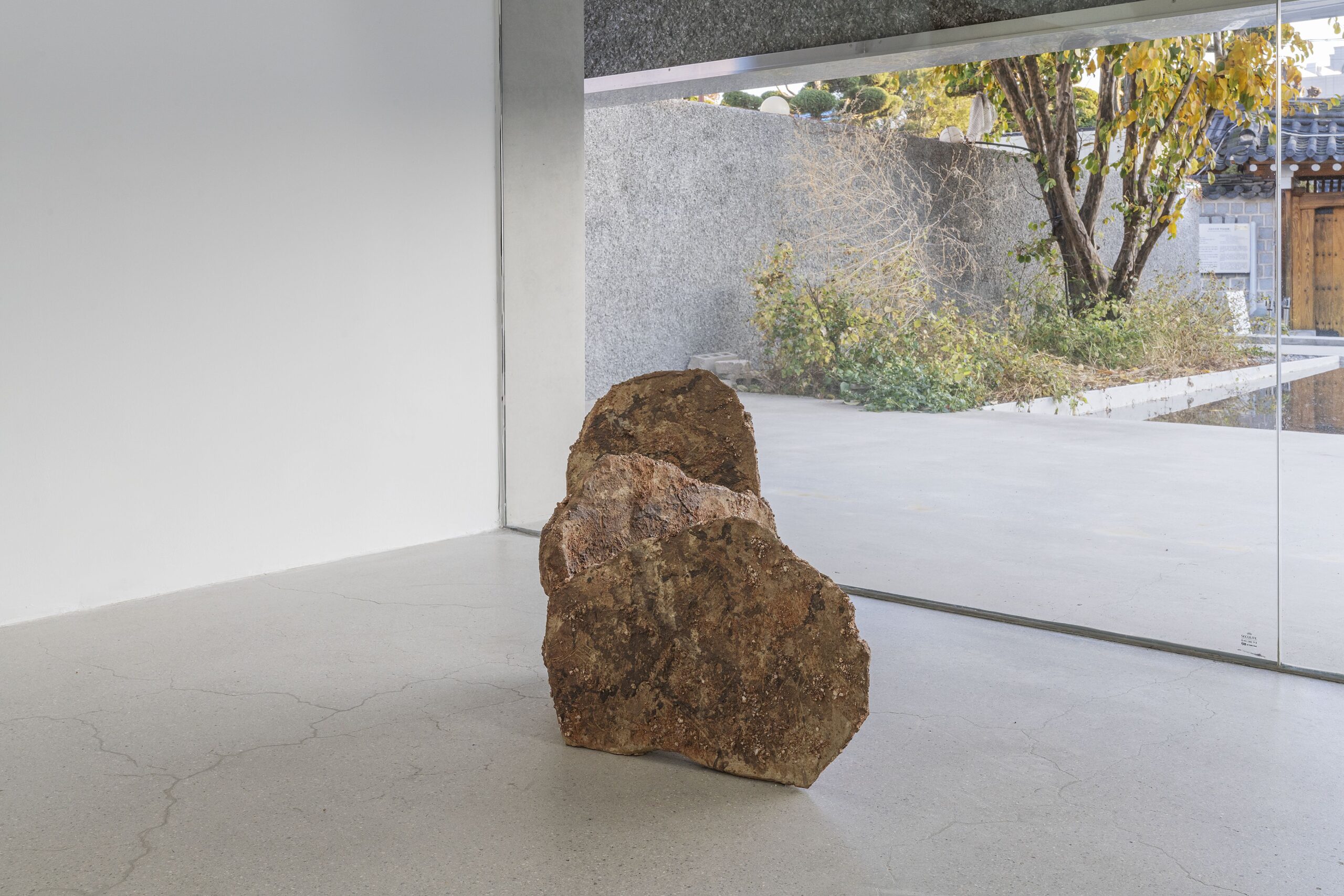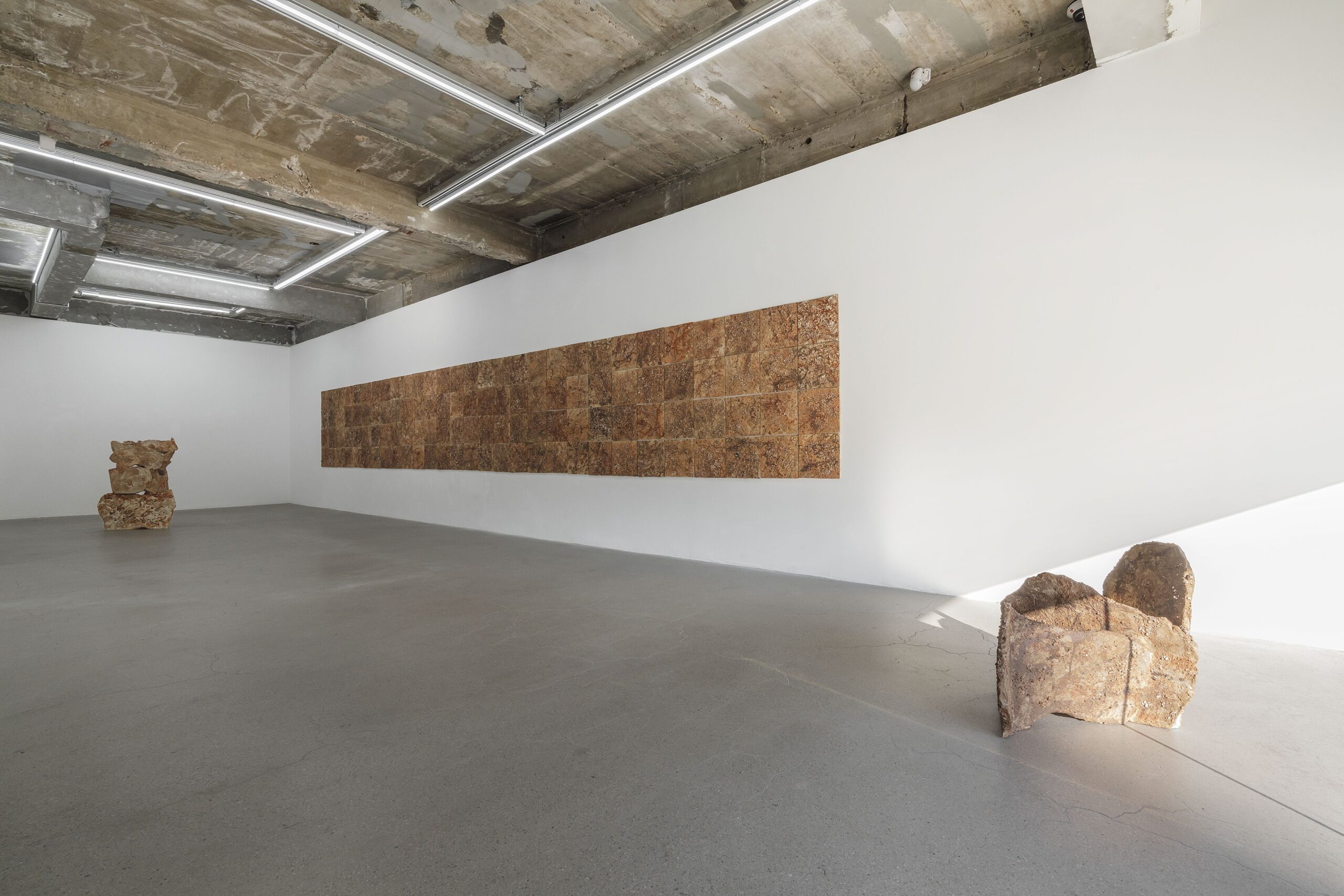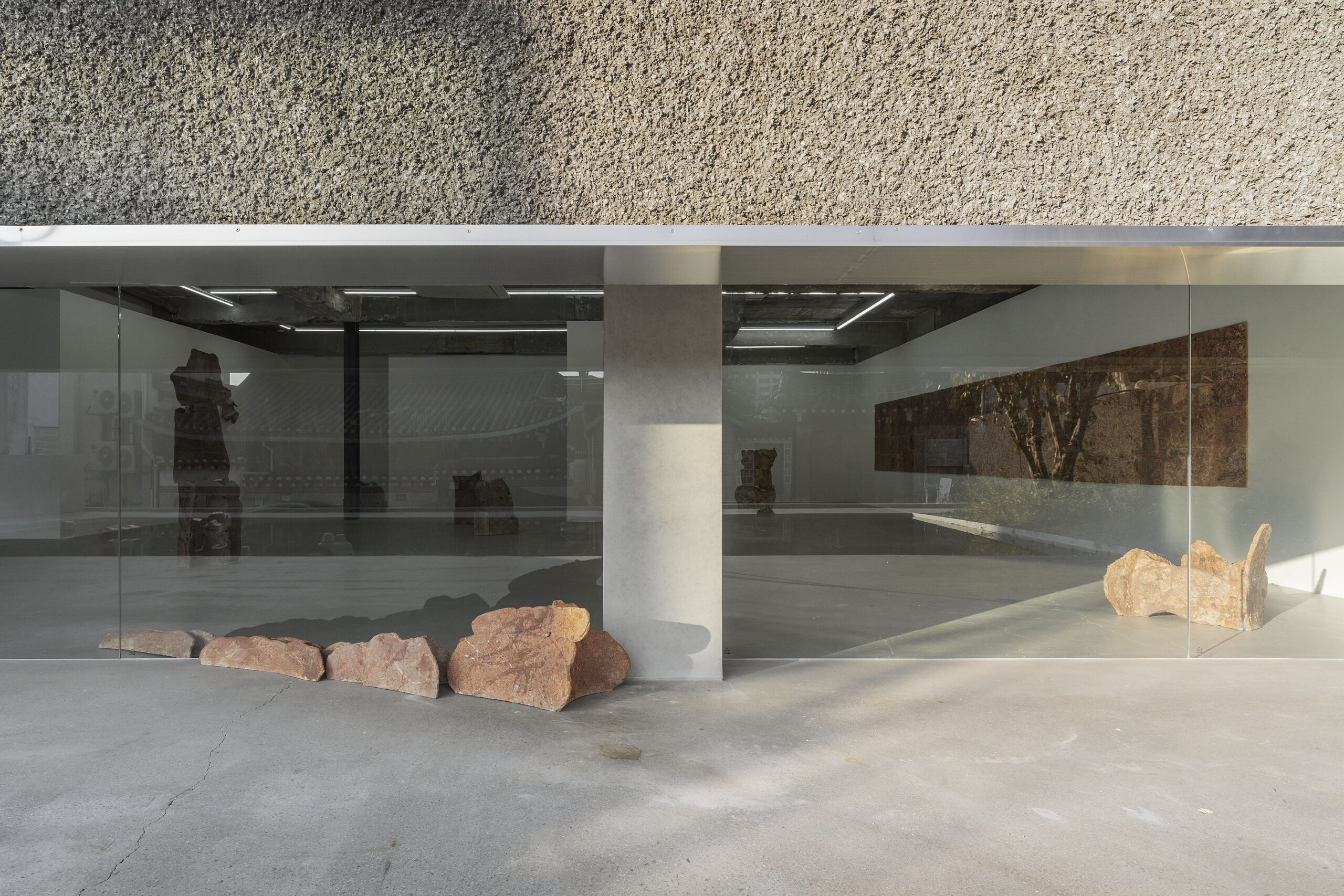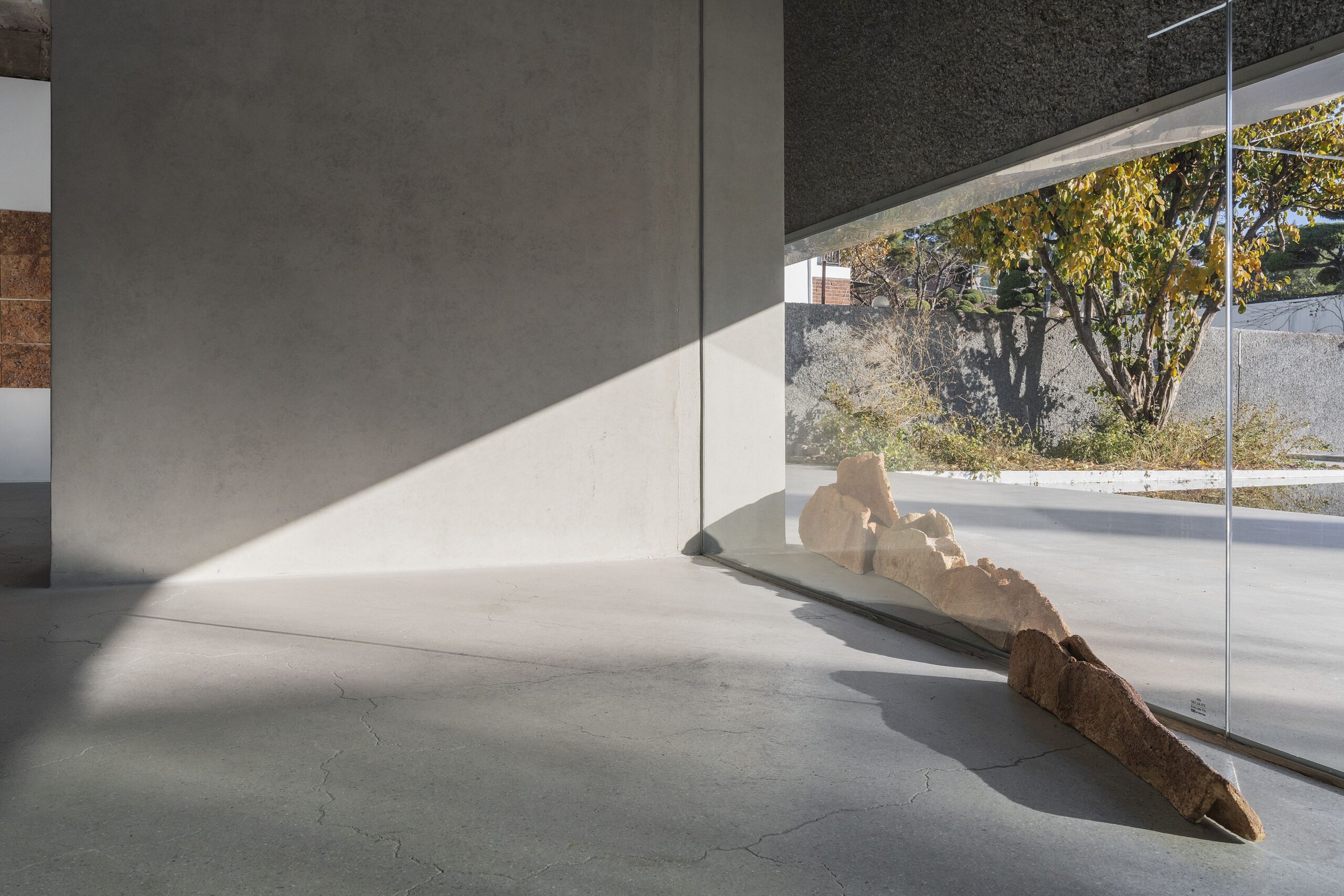«Rock & Roll»
문이삭 개인전
2022.11.24.-2023.01.28.
기획, 글 | 권혁규
설치, 도움 | 김준수, 조의주
가마 대여 | 번 도예공방, 스튜디오 콘10
진행 | 허호정
그래픽 디자인 | 윤현학
주최, 주관 | 뮤지엄헤드
후원 | 한국문화예술위원회, 한국예술창작아카데미
⠀
«Rock & Roll»
Isaac Moon
24.NOV.2022.-28.JAN.2023.
Curated by Hyukgue Kwon
Technical Support | Junsu Kim, Ui Ju Jo
Kiln Rental | Ceramic Studio Burn, Studio Cone10
Curatorial assistant | Hojeong Hur
Graphic Design | Ted Hyunhak Yoon
Hosted and Organed by Museumhead
Sponsored by Arts Council Korea, ARKO Creative Academy
얼핏, 문이삭의 조각은 매번 다른 곳을 향하는 듯 보인다. 그는 《사물들: 조각적 시도》(두산갤러리, 2017)와 같은 그룹전에서 3D 조각 기계의 작동 원리를 신체화하며 스티로폼(류)을 열선으로 깎아 두상, 손, 팔 등의 인체를 조형했고, 동료 작가(김웅현)와 협업한 《Passion. Connected.》(아카이브 봄, 2017)에서는 평창 올림픽 슬로건을 제목으로 내걸고 정상 궤도에서 이탈한 듯한 인체/조각/물질을 전시장에 흩뜨려 놓았다. 또 《분신술: 서불과차》(팩토리2, 2019)에서는 이미지/텍스트 인플루언서로 활동할 참여자들(김경태, 김익현, 김주원, 윤율리)을 초대해 조각의 물질과 경험, 기록이 온라인과 SNS 같은 여타의 시공간 속 좌표로 동기화되는 일종의 분신술을 실험했으며, 《BEAM ME UP!》(금호미술관, 2021)에서는 출력 가능한 물질의 동시대적 인지를 소조의 방법론과 충돌, 교차시키며 오늘 조각과 물질의 위상을 재고해보기도 했다.
누군가에게는 이번 개인전 역시 작가의 이전 작업과 또 다른 양상으로, 생경하게 다가올지 모른다. 《Rock & Roll》은 일련의 세라믹 작업으로 이뤄진다. 이미 《프라임 모뉴먼트》(N/A, 2021) 같은 전시에서 세라믹 작업을 선보인 바 있지만, 종전의 합성수지를 이용한 소조 작업을 알고 있는 이들에게 최근의 세라믹 작업은 전혀 다른 물질과 방법으로, 어딘지 어긋난 엉뚱한 실험처럼 보일 것이다.
(작업의 본거지는 추후에 살펴보기로 하고,) 다름으로 등장하는 흙과 세라믹을 따라가 보자. 전시장 곳곳에 놓인 <열개> 연작은 모두 서울의‘산’과 ‘바위’에서 출발한다. 문이삭은 서울 중심부의 북악산, 북한산, 인왕산의 이름 있는 바위들을 조각으로 만들겠다는 다소 황당한 목표를 갖고 해당 산에 올라 흙을 채집한다. 작가는 채집한 흙을 미리 만든 조형토 판 표면에 덧입히며 작업을 완성하는데, 여기서 전체 조각의 형상을 담당하는 조형토 판은 대상이 되는 바위를 직접적으로 지시, 재현하기보다 일종의 추상화 과정을 거쳐 만들어진다. 조형토의 형태를 잡기 전 작가는 바위를 서예나 한국화 드로잉을 하듯 종이에 먹으로 옮겨 그린다. 바위의 일부를 넓고 빠른 최소한의 면과 선으로 즉흥적으로 나타낸 붓질의 흔적이 바로 조형토 외곽 형태의 모티브가 되고, 그 면은 설명한 것처럼 산에서 가져온 흙으로 덮인다. 그렇게 만들어진 각각의 조형토 판들은 어린이용 입체 퍼즐 장난감처럼 교차되고 포개지며 직립 가능한 상태가 되고 최종적으로 소성 과정을 거쳐 하나의 조각으로 완성된다. 개별 판이 갖는 정면성과 시점을 여러 방향으로 쌓고 중첩시키며, 또 일부 파기하며 입체를 조형하는 것이다.
그리고 입체의 ‘표면’은 앞서 설명한 조형 과정의 또 다른 원칙을 구성한다. 그것은 산과 바위라는 대상과 경험의 증거물로서 조각의 재료인 흙을 전면에 드러낸다. 또 입산, 채집, 조형, 소성과 같이 통제할 수 없는 우연적 순간·사건과 모듈화된 과정을 동시에 발견케 한다. 다시 말해, 조각을 지탱하는 신체적 물질적 경험과 대상은 육중한 물질이나 다이나믹한 동세가 아니라 있는 그대로의 질료를 드러내는 표면의 시각성으로, 또 그것의 변화와 운동으로 인지되는 것이다. ‘표면’은 전시장의 긴 벽을 채우고 있는 <숨은 해골 촛대>와 같은 작업에서 더욱 두드러져 나타난다. 이번 전시에서 작가는 2021년 세라믹 작업 때와 달리 채취한 흙을 채로 거르거나 구분하지 않고 직접 작업에 사용한다. <숨은 해골 촛대>에서도 마찬가지로 준비된 흙을 마구 뿌리고 던진 후 일부 긁고 쓸어내며 각각의 판을 완성한다. 가져온 흙을 갖춰진 조형의 재료가 아니라 가공하거나 해체할 수 없는 물질로, 일종의 오브제로 작업에 고스란히 적용시키는 것이다. 이는 각 산에서 가져온 흙의 색인이라 할 수 있는 <능선>에서도 확인할 수 있다.
그럼 (누군가는 매번 바뀐다고 말할) 이 작업의 본진은 어디라 할 수 있을까. 전시작들은 다양한 조각의 역사와 방법을 경유한다. 작업의 표면과 질료로 규명되는 조형의 방법에서 근대조각의 시작을, 또 <능선>이 꽤나 직접적으로 지시하듯 물질 자체를 중요시하는 미니멀리즘 조각의 특정 장면을 떠올릴 수도 있다. 누군가는 여러 시점을 종합적으로 구성하는 과정에서 입체주의 조각을 말할지도, 나아가 입체주의와 추상표현주의, 그리고 현대 도예 간의 관계를 언급할 수도 있다. 엄청난 신체 활동을 기반으로 만들어진 절정의 물질로, 꺾인 산세 속 바위처럼 시공을 압축한 결정체로 이번 작업을 마주할지도 모른다. 조금 더 무모하다면 서예, 먹 드로잉과 추상의 관계로부터 김종영의 추상조각을, 흙과 세라믹에서 권진규의 테라코타를 불러낼 수도 있겠다. 이러한 접근을 명백한 오류라 할 순 없겠지만 그렇다고 전시에 딱 맞는, 충분한 설명이라고도 할 수 없다. 전시는 분명 앞서 언급한 미술들을 꽤 진지하게 또 농담처럼 참고하지만, 잠시 머무르거나 스치듯 교차할 뿐 정조준하지도, 완전히 포개지지도 않는다.
오히려 《Rock & Roll》은 어슴푸레한 산에서 마주친 날짐승 같은 고양이의 잔상을 형상화한 <트레킹>처럼 작가의 경험으로 설명될 수 있다. 혹은, 앞마당에 설치된, 여러 재료와 색이 혼합된 <디딤돌>처럼 과거 작업과의 관계를 떠올릴 때 더 명확하게 포착되는 듯하다. 일례로, 작업 전면에 등장하는 흙을 일종의 레디메이드나 오픈소스라고 우겨본다면, 또 흙의 형태를 결정한 먹 드로잉을 3D 제작을 위한 사전 인터페이스로 설명한다면 이번 전시의 작업 과정은 3D 모델링 프로그램을 경유해 스티로폼을 열선으로 깎은 과거 작업과 모종의 연결점을 드러낸다. 또 조형의 원칙이 발견되는 조각의 표면을 재호명하며, 직조와 표면이 작가 작업에서 늘 주요하게 자리해왔음을 언급할 수 있다. 이번 전시에서 조각의 사건과 체계, 신체와 물질, 그리고 그 안팎의 인지가 뒤섞여있는 표면은 작가의 첫 개인전이라 할 수 있는 《구성하고 그리고 쌓고》(공간 사일삼, 2016)부터 비교적 근작이라 할 수 있는 점토 직조 작업까지 그 맥을 공유한다.
조금 생경하게 다가오는 《Rock & Roll》의 물질과 방법론은 작가에게 새로운, 어긋난 시도가 아니라 이어진 작업의 확장과 이동으로 볼 수 있지 않을까. 이번 전시에서 산을 오르고 흙을 퍼오는 신체/경험, (마구 뿌려지고 감싸며) 원 상태 그대로 드러나는 재료, 완전히 통제할 수 없는 세라믹의 조형 과정 – 즉, 조각의 신체성과 물질성, 우연성은 문이삭 작업 전반을 관통하는 요체라고 말해볼 수 있지 않을까. 그렇게 스티로폼 조각은 프로그램 상의 오픈소스를 그대로 재현한 게 아니라 신체와 중력, 재료의 우연성을 적극 개입시킨 시도로, 탐사대와 인플루언서의 활동으로 끊임없이 포스트/리포스트되는 전시는 SNS 작동의 단순 차용이 아니라 동시대 조각의 존재 방식과 위상을 스크린 위에 직조한 사례로 이번 전시 《Rock & Roll》과 맞닿게 된다.
여기서 3D 모델링 프로그램과 온라인 공간을 거쳐 산을 오르고 바위를 조형하는 일련의 과정은 보다 자연스러운 흐름으로 다가온다. 코로나 팬데믹 이후 산은 작가를 포함한 많은 이들의 신체 활동, 혹은 신체 확인의 장소가 되었다. 당연히 그곳은 SNS 성지로 부상했고, 봉우리 정상에 자리한 유명 바위는 인생샷과 온갖 패션, 밈의 탄생지가 되었다. 저 우뚝 솟은, 그 무엇보다 기념비적이라 할 수 있는 산과 그곳의 바위는 오랫동안 많은 의미와 염원의 장소였으며, 이제 얼마 안 남은 신체, 새로 발견한 가상과 실제가 동기화되는 공간이다. 다양한 공간과 방법을 경유하며 조각의 존재 방식을 탐색해온 작가에게 산과 바위는, 또 흙과 세라믹은 아이러니하게도 기존의 조각을 또 그것의 지각을 확장할 수 있는 너무나도 당대적인 공간은 아니었을까. 그렇게 작가는 신체적이고 촉감적인 동시에 직관적이고 시각적인 행위를 극대화하는 장소이자 재료로서 산과 바위, 흙과 세라믹을 내놓는다. 이는 플라스틱으로 플라스틱을 만든 과거 작업처럼 흙을 흙으로 등장시키며, 물질을 중심으로 신체적이고 우연적인, 동시에 보다 분명한 조각의 발생을 꾀한다. 특정 공간과 재료, 방법으로 스스로를 테마화하는 듯한, 변화무쌍한 그동안의 작업은 사실 조각의 존재성에 관한 사고를, 입체 조형과 그것의 관습 그리고 인식에 관한 질문을 지속하는 움직임이라 할 수 있지 않을까. 그것이 기존 사물의 체계로부터 어떤 자립을 이뤄냈는지 당장에 결론을 내릴 순 없겠지만, 《Rock & Roll》이 그 시도를 조금 더 멀리 쉬지 않고 굴려보는 동작임은 분명해 보인다.
기획/글 권혁규
At first glance, Isaac MOON’s sculptures seem to head toward different directions. In the group show Things: Sculptural Practice(Doosan Gallery Seoul, 2017), MOON transformed styrofoam into bodily forms of human head, hands, and arms. It was made with his body, gravity, and heating wire with reference to a 3D CNC machine. In the collaborative project with artist Woonghyun KIM, Passion. Connected.(Archive Bomm, 2017), he scattered the bodies/sculptures/materials that seem to have derailed from normal orbit in the exhibition space, with the PyeongChang 2018 Olympic & Paralympic Winter Games slogan as the show’s title. In CLONE TECHNIQUE: SEEKING ELIXIR(factory2, 2019), MOON experimented with a form of cloning by inviting image/text influencers(artists Kyoungtae KIM, Ikhyun GIM, and Joowon KIM, and curator YOON Juli) to enact how sculptural forms, experiences, and records can become synchronized with other temporal and spatial coordinates, such as the internet and SNS. In BEAM ME UP!(Kumho Museum, 2021), he reconsidered the place of present-day sculpture and materials by colliding and intersecting contemporary perceptions of printable materials and methodologies of sculptural modeling.
Rock & Roll might come across unfamiliar, taking somewhat different shape from his previous projects. The exhibition consists entirely of a series of ceramic works. He presented works in ceramic in shows like Prime Monument(N/A, 2021) and for those who had been introduced to his synthetic resin sculptures, MOON’s recent ceramic projects would seem like an experiment gone astray, dealing with an entirely different material and methodology.
(Set aside the discussions of his works and their base of operations for now and) Let’s follow the seemingly new components of soil and ceramic. The Dehiscence series, dotting the exhibition space, all begin from “mountains” and “rocks” of Seoul. With a rather absurd aim to create sculptures out of the named rocks of Mt. Bugak, Mt. Bukhan, and Mt. Inwang at the center of Seoul, MOON climbed the mountains and collected the soil. He then finished the work by overlapping the collected soil to the surface of prepared clay plates. The clay plates that make up the sculptural form do not directly indicate or represent the rocks they were made after but their forms are created through a certain abstraction. Before making the form, the artist translates the rocks on paper with ink stick as in calligraphy or Korean traditional painting. The traces of ink spontaneously brushed with broad and fast strokes into the minimal surfaces and lines, represent the parts of the rocks and become the motives for the external form of clay structure. Following that, the surface of these structures is covered with soil brought from the mountains explained above. The clay plates are then intersected and piled up like children’s three-dimensional puzzles to stand upright and through the firing process, they turn into a sculpture. The individual plates, each with its frontality and perspective, are compiled, repeated, or partially destroyed, to form a single three-dimensional figure.
The “surface” of three-dimensional form composes yet another principle of aforementioned creative process. Its surface brings to the fore the soil which is the medium of the sculpture, and with it, the sculptural object of the mountains and rocks and the evidence of the artist’s experience. It also allows viewers to simultaneously discover on one hand the chance moments and incidents of climbing the mountains and collecting, molding, and firing of the materials that cannot be controlled, and on the other hand, the modulated process. In other words, the corporeal and material experience and the object that sustain the sculpture are not shown by the weighted material or its dynamic movement of the sculpture. Rather, what supports it is the visuality of sculpture’s surface which display the medium as itself, and perceived changes and movements of that visuality. The “surface” is more highlighted in the works such as Sumeun haegol chotdae(2022) that fill the long walls of this exhibition. Unlike in the previous 2021 ceramic project where MOON used sifted and sorted the soil, this time, the artist directly applies it in his work. Also in Sumeun haegol chotdae, MOON randomly sprays and throws soil onto the plates and finishes the work by partially scratching and brushing the surface. The collected soil is applied not as a medium of modeling but as a material that cannot be processed nor be deconstructed─an objet in itself─and it is applied in the work as is. Such an application can also be found in The ridge(2022), which is an index of soil from the mountains.
What then, is the essential concern for MOON’s works (which, some will argue is constantly changing style)? The displayed works transit various histories and methodologies of sculpture. One might be reminded of the beginning of modern sculpture in the ways his works are defined by their surfaces and media, or, from the quite indicative aspect of The ridge, recollect the emphasis on the material itself in the Minimalist sculpture scene. Some will speak of Cubist sculpture in its synthetic composition process of various perspectives, and further, refer to relationship between Cubism, Abstract Expressionism, and contemporary pottery. Some would face these works as the ultimate materials consisting of extensive corporeal activities or as the spatiotemporal compression, like the rocks of tumultuous mountain ridges. If we can be bolder, one could call forth the abstract sculptures of KIM Chong Yung from its relationship between ink drawings and abstraction, or, KWON Jinkyu’s terra cottas from the soil and ceramics. These approaches are not entirely erred, however, they are not appropriate for or do they sufficiently explain the case of Rock & Roll exhibition. The exhibit quite earnestly and humorously references aforementioned arts, yet it does not directly aim for or entirely overlaps with those works; it only briefly lingers on and intersects with them.
Rather, Rock & Roll can be explained from the artist’s experience, as in the case of Trekking series(2022) which visualize the afterimages of cats─the wild things one might come across in the dimly-lit mountains. Or, like the mixed material and multi-colored Stepping Stones(2022) in the gallery’s front yard, its essence can be captured more clearly through its relationship with the artist’s previous works. For instance, if we could argue that the soil at the frontline of MOON’s works’ operations is a type of readymade or an open source and the ink drawing that decided the form of the soil as a base interface for three-dimensional printing, the working process of this exhibit reveals a certain connection with MOON’s previous works that carved styrofoam with heating wire by viewpoint of 3D modeling program. In addition, this perspective calls forth the sculptural surface upon which the principles of the artist’s making process take shape, and the constant importance of weaving and the sculptural surface in the artist’s oeuvre. The concept of the surface in this exhibit, which mixes sculptural event and structure, body and material, and the sculpture’s internal and external perceptions, shares the line of thoughts that stretch from the artist’s first solo show Construct(Space Four One Three, 2016) to his relatively recent synthetic resin sculpture.
Slightly foreign materials and methodologies of Rock & Roll can be seen as an extension and migration from MOON’s works rather than a new and mis-stepped attempt by the artist. The bodily experience of climbing the mountains and shoveling of the soil, the exposure of bare medium (randomly thrown and covering the surface), the ceramic making process that cannot be entirely controlled, in other words, the corporeality, materiality, and spontaneity of sculpture, could be called the essence that pierce the entire body of Isaac MOON’s oeuvre. In this way, this exhibition can be connected with his previous styrofoam sculptures and the images which were continuously posted/reposted on SNS by the influencers. The former, in that it is an attempt to actively involve the spontaneity of body, gravity, and the material rather than a blind representation of program’s open source, and the latter, as an example of weaving the contemporary sculpture’s ways of existence and status rather than a simple adaptation of SNS’s working process.
With these connections set up, the series of process starting from three-dimensional modeling program and online space, to climbing the mountains and modeling the rocks comes across as more natural. Ever since the pandemic, the mountains have become the site of corporeal activity and corporeal confirmation for many, including the artist. There became social media hotspots, and the famous rocks positioned at the top of mountains became a birthplace of photo shots, all kinds of fashions, and memes. The towering mountains and rocks, most aptly called as monuments, have long been sites of varied meanings and wishes, and are now sites where the barely remnant human body, newly discovered virtual space and the reality are being synchronized. For the artist who has been exploring the ways of sculpture to exist through various spaces and methods, the mountains and rocks, and the soil and the ceramics, ironically, could have been all-too-contemporary space to extend the boundaries of sculpture and its perceptions. In this manner, Isaac MOON presents the mountain and the rocks, the soil and ceramics as a site and medium to amplify the actions that are simultaneously corporeal/tactile, and intuitive/visual. The project Rock & Roll presents soil as soil as in his previous works that worked plastic to create plastic. And it aims for a corporeal and spontaneous, yet much clearer genesis of sculpture centered through the material.
The ever-changing sculptural styles of MOON’s oeuvre that seem to thematize themselves through a certain space, medium, and methodology could, in fact, be construed as a continuous movement to question the ideas of sculpture’s existence, three-dimensional sculpture and its practices, and of its perceptions. It will be hasty to print a final word on how MOON’s works acquired independence from the structure of previous objects at this moment. However, it seems certain that Rock & Roll is a gesture to continue turning that engine of attempts to go─just a little bit further.
Kwon Hyukgue
Translated by Yoonjung Colleen Choi


